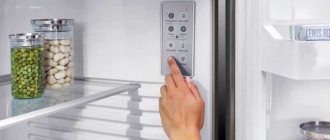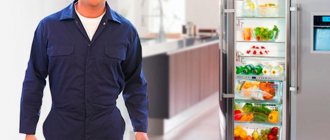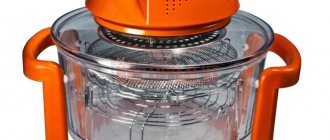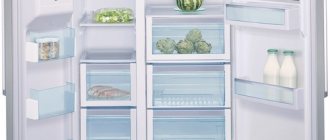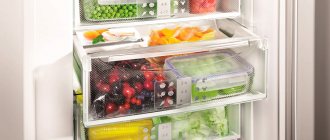Walking through supermarkets every day, you see a lot of frozen fruits and vegetables in attractive packaging. Oh, how I want to try them all, especially when it’s “out of season”! But they are quite expensive and not affordable for everyone, especially in large quantities.
In order not to overpay per kilogram of berries, you can buy a chest freezer or freezer cabinet for your home. Expensive? But such a purchase will definitely be worth it. Having a large freezer, you can buy a couple of buckets of seasonal fruits or vegetables, meat at wholesale prices, go fishing, and then enjoy fresh food at any time of the year.
Chest freezer or cabinet: features, advantages and disadvantages
The fact is that both chest freezers and freezers are presented in a large number of different models that are suitable for both business and home. However, it is worth understanding their main advantages and disadvantages in order to decide what is better in a particular case.
Chest freezer
The chest is a horizontal single-chamber device. Typically, such a unit has a large internal displacement. At the top of the chest you can attach special baskets for convenient placement of products. The lower part of the freezer is designed for storing large products.
Advantages
- Large chamber volume. Allows you to load a large number of products.
- Horizontal loading. Reduces condensation formation and keeps the device cool.
- Thermal insulation. Due to the fact that the lid is located on top, it presses the seal under its weight, which creates a good seal.
- Electricity. It consumes a small amount of electricity, since it has only one chamber and additional systems that require additional energy to operate are less often installed in chests.
Flaws
- They occupy a significant area due to horizontal placement.
- Designed for long-term storage of products. This reduces the possibility of storing small-piece products.
- There is no specific storage system. Despite the presence of upper drawers, all the products are piled up (especially in the lower part). Even the boxes don’t help the situation much, since they either don’t hold many pieces, or they are too deep and everything is piled on top of each other.
Freezers
Freezers are very similar in appearance to refrigerators. They even have a large number of different functions, systems and capabilities that housewives are accustomed to seeing in ordinary household refrigerators.
Advantages
- Occupy a small amount of space. Thanks to the horizontal type of installation, they do not take up much space, and they can also be built into the kitchen wall.
- Convenient loading. Thanks to the presence of shelves, drawers, containers (and in some models even special cells), products can be conveniently laid out in such a way that each of them will be accessible, without having to remove other products.
- Designed for everyday use. The freezer door is not heavy and is designed to be opened quite often. Therefore, it is convenient to store small-piece products in such a unit.
- Two compressors. Depending on the ambient temperature and the amount of food, the cabinet automatically turns on one or both compressors.
Flaws
- Due to vertical loading, moisture accumulates and frost forms.
- The density of the elastic band. Over time, its density decreases, which reduces the fit of the door. The worse the door is attracted to the device chamber, the more frost forms inside.
- Electricity consumption. The freezer consumes more electricity due to the presence of two compressors, as well as additional systems (such as No Frost, etc.).
With or without No Frost?
There are two main types of cooling systems in freezers - drip, also known as static, and No Frost. The price of a freezer with “static” is much lower, but it needs to be defrosted manually, while more advanced devices with No Frost require less maintenance. Let's take a closer look at these varieties and their features.
A freezer with a static cooling system differs in its operating principle from conventional “crying” refrigerators, and its main difference is that it does not “cry”. In the refrigerator, when the compressor is running, moisture settles on the back wall of the refrigeration compartment, since the temperature on its surface is at its lowest at that moment. When the compressor turns off, the temperature inside the refrigerator begins to gradually increase, and the inner surface of the back wall ceases to be icy, and the moisture frozen into ice again becomes droplets and flows down to a special groove for draining excess liquid. This cooling principle eliminates the rapid and large-scale freezing of ice and frost, but it only works in the refrigerator compartment, since the temperature there is above zero. But in freezers the temperature is always very low, so moisture accumulates and freezes without defrosting. For this reason, both freezers and chests must be defrosted manually every 3-6 months.
This is interesting: The principle of operation of the freezer is simply about the complex
The No Frost system is very convenient, which is why users always leave very good reviews for such freezers. Chests, unfortunately, are not available with this cooling system. Devices with No Frost do not accumulate moisture, but remove it, so that both the inner walls of the freezer compartment and food packages are not covered with a crust of ice, but remain dry. Because of this dryness, by the way, all products inside the freezer or chest must be carefully packaged so that they do not chaff or dry out. Freezers and chests with a No Frost cooling system also need to be defrosted and washed from time to time, but this is required specifically for hygienic purposes.
comparison table
| Index | Chest | Freezer cabinet |
| Loading | horizontal | vertical |
| Capacity with chamber volume 100 l | about 90 l | about 80 l |
| Electricity consumption | class A++, A+++ | class A, A+ |
| Storage system | drawers and space | drawers, retractable and stationary shelves, cells. |
| Price | relatively not high | relatively expensive |
Cost of the device
The size of freezers has a major impact on pricing. Therefore, it is worth choosing a unit that meets your needs and not chasing excessive internal volumes.
- Budget options for freezers that have a standard set of functions will cost around 16-20 thousand rubles. Such models of devices are very popular among the bulk of the urban population.
- The average price category of freezers includes devices whose cost ranges from 23 to 30 thousand rubles. They are already larger in size than the budget models described above and are designed for large families.
- The most expensive and “sophisticated” ones include products whose cost exceeds 40 thousand rubles. They have a beautiful design, a maximum number of functions and many different improvements designed to make the operation of refrigeration equipment more comfortable.
What to choose for your home: freezer or chest?
You should choose based on the needs of a particular family. In addition, you should carefully study each model you like.
Reference! But in general, it is worth noting that a freezer is more convenient for storing and freezing food at home.
Capacity
For home use, models with a volume of up to 300 liters will be sufficient. You can purchase a device of smaller volume. For example, if only fruits/vegetables are frozen, then it is better to choose small models with a volume of up to 100 liters. If your family often freezes semi-finished products, then you should pay attention to models with a volume of about 150 liters. And for freezing various meats, it is better to choose devices up to 300 liters.
Large freezers (with a volume of 500 liters or more) should not be purchased for home use, since even for the largest family it will be problematic to fully load such a model, and the energy consumption will be significant.
Built-in or free-standing
In this case, you should choose based on the interior design and the possibility of placing the device. In addition, only freezer cabinets can be built in; you will have to find a place for chests.
Autonomous cold storage
Some devices are able to remain cold for some time after being disconnected from the network. Therefore, it is important to consider such a feature in cases where frequent power failures occur.
Super freezing - is it necessary or not?
This feature is available in some freezers to quickly freeze large items without damaging the food's internal structure. Super freezing is necessary in case of long-term storage, so it is worth deciding whether it makes sense to overpay for an additional function.
Electricity consumption
The devices use consumption classes C, B, A, A+, A++, A+++. The least economical devices of classes C and B, it is not recommended to install them at home.
Control system - electronic or electro-mechanical
And although in some devices you can still find a completely mechanical control system, it is becoming less and less relevant. Many manufacturers install mechanical buttons and levers and complete the device with a display. Others make the control panel completely electronic. In principle, electromechanical control will be sufficient for home use (it allows you to set modes and temperatures quite accurately).
Important! Models with all-electric control have a significant cost.
Defrosting method: with or without “No Frost”
There are freezers that defrost manually. To do this, you need to turn off the freezer on a regular basis, wait until it is completely defrosted, then rinse it, and then start it up again.
Automatic defrosting and No Frost system allow liquid to flow into a specific container and evaporate. Therefore, there is no need to turn off the device.
Freezing temperature
Marking of devices by temperature conditions is indicated by “*” with this sign. The most optimal devices are with three stars (from -18 to -24 °C), those with one or 2 stars freeze to only -12 degrees.
Power
Capacity indicates how much food the device can freeze in a certain period of time (usually an hour). It depends on the volume of the chamber. The following are considered optimal:
- devices up to 100 l – 4-5 kg;
- up to 150 l – 10-11 kg;
- up to 200 l – 16 kg.
One or two compressors?
If the device has large dimensions and a good chamber volume, then you should opt for a model with two compressors. If necessary, the device will automatically turn on/off the second compressor, but no power will be lost. For small models, one compressor is sufficient.
Space requirements
To determine what size you need, multiply the number of people in your household by 0.8 cubic meters. meters. The answer will tell you what size freezer you need. For example, my family of four needs a freezer capacity of about 3 cubic meters.
If you really like to shop a lot of groceries or have a hunter or fisherman in the family, you may need more space.
Pro tip : When measuring space for any type of freezer, be sure to add at least 0.3 cubes to the width to allow air flow around food.
What to choose for business?
For commercial purposes, larger volume models should be selected. However, a chest or freezer depends on the purpose. In shops and supermarkets it is worth giving preference to display chests for displaying and storing goods. Various units can be installed in utility rooms.
For small-piece products (semi-finished products, vegetables, fruits, etc.), it is better to choose freezers. If it is necessary to store fish, meat, etc. for a long time, it is better to give preference to capacious and convenient chest freezers.
Built-in or free-standing?
When the interior of the kitchen is checked to the smallest detail, large household appliances simply do not fit into the scope of the design idea, so they are masked with the facades of kitchen furniture, removing any hint of diversity. It is in such cases that a built-in freezer will be an excellent choice - maximum functionality while being completely invisible.
But if you want to buy a built-in device, you will have to decide which freezer is better - built-in chests are simply not produced. But the vertical models are varied, so choosing both a small countertop freezer and a tall full-size model will not be difficult, and you will get impeccable unity of style. But there is an important point here.
If an ordinary free-standing freezer can, if necessary, migrate not only throughout the kitchen, but also go to a temporary or even permanent place of residence on the balcony, in the basement or in any utility room, then with built-in models such castling will no longer work. Rearranging a built-in freezer is difficult - at a minimum, you have to change some of the furniture facades, and such a move will affect, if not the entire situation in the kitchen, then almost all of it.
Advantages of purchasing from Eco-1
Eco-1 company is a manufacturer of refrigeration equipment. The supply of equipment to the regions of Russia and the CIS countries is organized through a dealer network, which allows us to maintain low prices for chests and cabinets for consumers.
For production, we use materials and components from the world's leading manufacturers; the assembly quality of our products is controlled according to all standards. The construction and design of the equipment takes into account modern trends, and its operational and ergonomic characteristics fully comply with current requirements.
You can order the necessary equipment on the company’s website or by phone. In Moscow, the company's products are delivered free of charge; for delivery within the region, the price is 25 rubles per kilometer outside the Moscow Ring Road. Delivery to other regions of the country is possible thanks to a developed logistics network.
You can find out more about delivery methods outside the Moscow region from the manager by phone. Call and get comprehensive information on all your questions.
